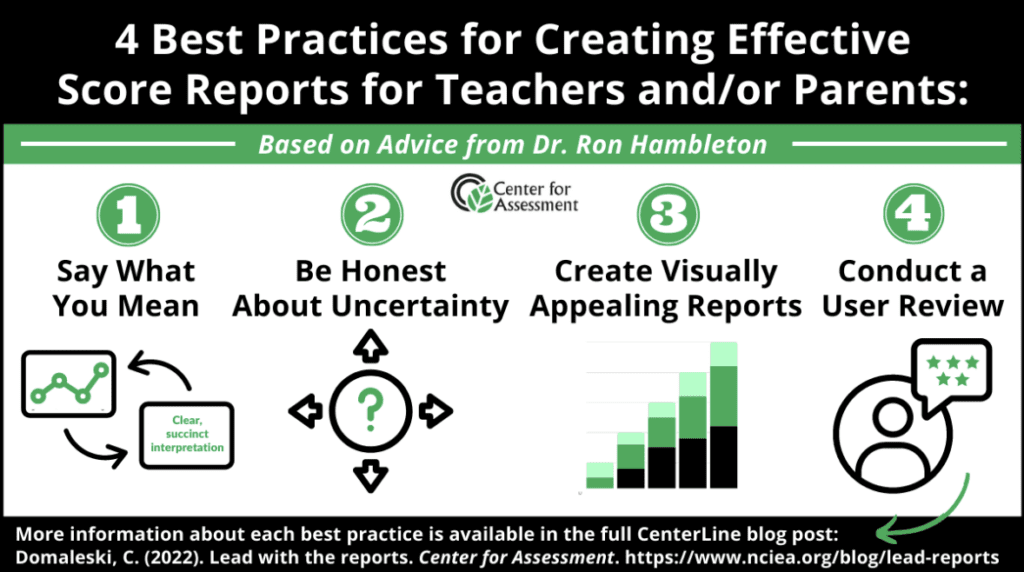Lessons Learned about Effective Communication from the 2022 Brian Gong Colloquium
In a time of elevated confusion and mistrust, it’s never been more important to communicate clearly and effectively about educational assessment and accountability.
Do you want to spark a spirited debate in education policy circles – or really just about anywhere? Simply ask for one’s opinion about the role of standardized tests or school accountability systems in education. The ensuing conversation will be anything but dull.
There is no shortage of strong opinions on these topics. Many, perhaps most, will describe frustration with increasing assessment and accountability demands and misgivings about the value of the results. Others may advocate for a renewed emphasis on getting trustworthy information about student achievement and school performance in the wake of pandemic disruptions. The conversation is sure to elicit a variety of views about what information is needed and how it should be used.
This was the context that inspired us to select the topic for the 2022 Brian Gong Colloquium: Boosting the Signal Through the Noise: Strategies for Improving the Clarity and Reach of Communications about Assessment and Accountability.
The Brian Gong Colloquium
Named for our esteemed co-founder and longtime Executive Director, Brian Gong, the Colloquium is held annually as a learning opportunity focused on a topic with important implications for practice. Among other benefits, the Colloquium gives us a chance to step outside our primary area of expertise. Accordingly, we invite a small group of guests with knowledge and skills in areas we think complement our work. This year, we were fortunate to learn from some amazing experts. Our guests included education writers, communication professionals, reporting and data visualization specialists, and policy leaders. Over the course of a day and half, we enjoyed learning about strategies to be more effective communicators.
We regard engaging in these discussions as essential to helping our clients get the most from our contributions.
Four Communication Keys Inspired by Discussions at the 2022 Brian Gong Colloquium
The remainder of this post is our attempt to summarize some of the prominent points and lessons learned from the Colloquium. While our reflections are a credit to the contributions and expertise of our guests, it is important to note that the content of this post reflects our interpretations, and any shortcomings are ours alone.
Sometimes “Just Enough” is Enough
Perhaps you’ve heard the expression, if I ask for the time, please don’t explain how to build a watch. Similarly, there may be a tendency in highly technical or specialized fields to overcommunicate. That tendency may be motivated by a commendable desire to provide very complete and precise information; but it’s easy to lose the audience.
This principle has implications for the nature, timing, and format of communications. For example, imagine a scenario in which there is a problem to address, such as an unplanned interruption during an assessment administration. The “Just Enough” principle suggests that it’s best not to wait until everything is known about the issue before addressing the field. One might start with acknowledging the issue and providing clear, actionable, steps for how to proceed if your school is affected by the interruption. Subsequent and separate communications may provide more information about what happened, how it will be remedied, and how it impacts results. Such an approach would be preferable to waiting until everything is known and issuing a full report that’s likely too late and too overwhelming.
This principle is also important when communicating about complex or nuanced topics. For example, there are a lot of factors to consider when providing guidance about how to meaningfully interpret assessment results in light of pandemic disruptions. For technical audiences, a deep dive may be appropriate. But for general audiences, it’s important to focus on a manageable number of high priority messages, such as the importance of considering the impact of participation rate when interpreting school performance.
Expand Your Communication Toolkit
When it comes to communicating about assessment and accountability, some measurement professionals may rely on one or a small number of communication tools. Traditionally, these tools may include an academic paper or a technical brief. However, if the goal is to reach broader audiences, we need a bigger toolbox.
Let’s start with the communication medium. Academic papers and technical briefs have value, but they’re not enough if the objective is to expand reach and appeal to a wide range of stakeholders. Blogs are another good option. Regular readers of CenterLine know that our objective with this blog is to write more frequent and focused articles on topics of broad interest with minimal jargon. Other communication tools include videos, podcasts, toolkits, or social media. Each of these tools has advantages and limitations, but they all offer a means to reach more people more quickly, and more conveniently, than traditional papers. Additionally, many of these approaches will be most effective when “just enough” information is shared.
The Center has been working to leverage many of these communication tools for many years, aided by our partners at Fishnet Media. At the colloquium, we discussed some ways to get more value from the tools, including the creation of compelling visuals to accompany our content. For example, one of our invited experts, Jessica Rodrigues from the University of Missouri, created the following visual summary of one of my (Chris) previous CenterLine posts to illustrate the potential.

Jessica has an amazing talent for creating visually appealing resources and we urge readers to check out her work more fully here.
In sum, we learned that these and other tools showcased at the Colloquium have the potential to increase the reach and impact of educational research, drawing them out from scarcely-read journals and technical reports and into the hands of users.
Promote Reciprocal Communication
Too often, communication about assessment and accountability is one-way. This outdated approach assigns no responsibility to the communicator other than to broadcast information.
More contemporary practices embrace reciprocal or more dynamic communication. Supporting this type of communication requires both tailoring the message to the audience and engaging the audience as an active participant in the communication process. For example, suppose a state education department is implementing revisions to the school accountability system. State leaders may start by crafting messages about these revisions specific to various audiences such as parents, educators, district leaders, etc. Then, provide supports to assist with follow-up. Is there a way stakeholders can get more information, such as accessing online resources or contacting a state official? How can users provide feedback or suggestions? Perhaps the communications plan includes an online survey or contains an invitation to participate in an interactive webinar.
The communicator’s responsibility doesn’t stop after the initial message is sent. Instead, it’s the start of a process involving cycles of interaction and support to promote the intended interpretations and use.
Include Communication in Your Theory of Action
It will come as no surprise to those familiar with the Center’s work that the Colloquium included a discussion of the importance of a theory of action. Indeed, many of our colleagues at the Center have written extensively about the importance of theories of action to aid in the design and evaluation of assessment and accountability systems (see, for example, Nathan Dadey and Brian Gong’s work here).
In the current context, we learned about the importance of including communication explicitly in a well-developed theory of action. For example, if a school district is developing a set of assessment resources to provide more useful instructional information to educators, include in the guiding theory of action a plan for when and how to communicate about the initiative. That plan should address what each key stakeholder needs to know and how best to provide that information in compelling and dynamic ways. The theory of action should also specify how to monitor and improve communication over time to get the most from the initiative.
Final Thoughts
We know there are no easy or quick fixes to the range of challenges that elicit strong opinions about assessment and accountability. Some challenges may require changes to policy, while other concerns could be addressed by improving the technical quality of assessments. But we believe that more effective communication can be an important part of an overall plan to get a clearer signal from the noise.
Special thanks to the esteemed guests listed below who joined us at the 2022 Brian Gong Colloquium to share their expertise.
- Catherine Gewertz, Education Week
- Jennifer Keefe, Fishnet Media
- Thomas McCarthy, Wisconsin Department of Public Instruction
- Jessica Rodrigues, University of Missouri
- Clare Sims, Boulder Valley School District
- Dana Tofig, American Institutes for Research
The post Boosting the Signal Through the Noise appeared first on Center for Assessment.


